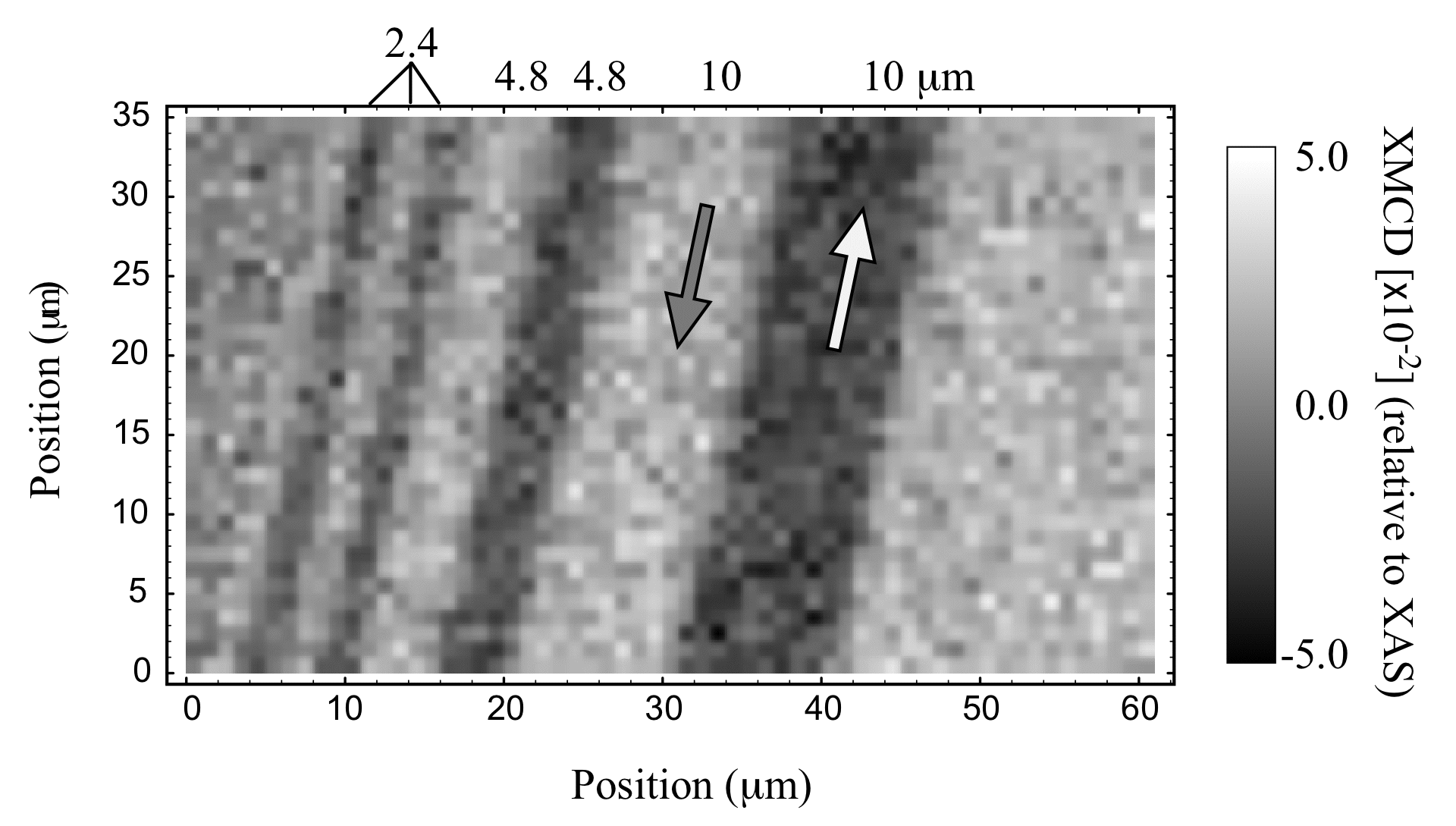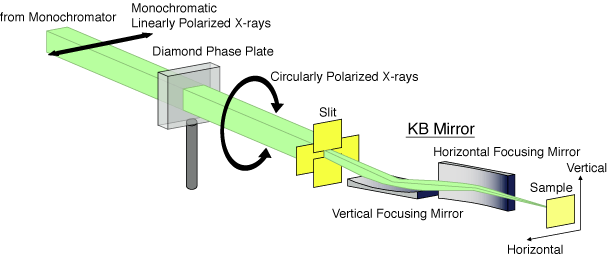Scanning X-ray magnetic microprobe
問い合わせ番号
SOL-0000001036
ビームライン
BL39XU(X線吸収・発光分光)
学術利用キーワード
| A. 試料 | 計測法、装置に関する研究 |
|---|---|
| B. 試料詳細 | 磁性体 |
| C. 手法 | 吸収、及びその二次過程 |
| D. 手法の詳細 | XAFS, XANES, MCD, LD |
| E. 付加的測定条件 | 偏光(円、楕円), マイクロビーム(1-10μm), 二次元画像計測, 磁場(< 2 T), 室温 |
| F. エネルギー領域 | X線(4~40 keV) |
| G. 目的・欲しい情報 | スピン・磁性構造 |
産業利用キーワード
| 階層1 | 記憶装置 |
|---|---|
| 階層2 | HD、MO |
| 階層3 | 磁性層, 磁気ヘッド, スピンバルブ膜 |
| 階層4 | 磁化, 磁気異方性, 界面磁気構造 |
| 階層5 | XAFS, XMCD, イメージング |
分類
A80.14 磁性材料, M40.30 磁気吸収
利用事例本文
Scanning X-ray magnetic microprobe is a unique tool to obtain a two-dimensional magnetic image of specific magnetic elements comprised in the sample. Available spatial resolution is approximately 2 m. The technique is applicable to magnetic materials containing 3d transition metal, rare earth, and 5d noble metal elements. It also allows X-ray magnetic circular dichroism (XMCD) or XAFS measurements for a specific area of a few m square. The figure shows a magnetic image taken for a CoCrPtB in-plane magnetization film. Magnetic recording patterns were observed as an XMCD contrast of X-ray fluorescence intensity at the Pt L3 edge. The stripe of 2.4 m width was clearly resolved.
Fig. Magnetic image of a CoCrPtB in-plane magnetization film,
taken using the scanning X-ray magnetic microprobe.
画像ファイルの出典
所内報
誌名
ナノテクノロジー総合支援プロジェクト研究成果報告書 Vol.4, 2004年A
ページ
p. 147
測定手法
The scanning X-ray magnetic microprobe consists of a diamond X-ray phase plate and X-ray focusing mirrors (KB mirror). Monochromatic X-rays from the beamline monochromator are converted into circular polarization by the phase plate, and then focused onto a sample by the KB mirror. The focused spot size is 2 m. X-ray magnetic circular dichroism (XMCD) signal is recorded by monitoring X-ray fluorescence intensity from the sample with changing the incident X-ray photon helicities; the XMCD signal reflects the magnitude or direction of sample magnetization. A magnetic image is taken by two-dimensionally scanning the sample position using high-precision motorized stages.
Fig. A schematic of the scanning X-ray magnetic microprobe.
画像ファイルの出典
所内報
誌名
ナノテクノロジー総合支援プロジェクト研究成果報告書 Vol. 4, 2004年A
ページ
p. 146
測定準備に必要なおおよその時間
3 シフト
測定装置
| 装置名 | 目的 | 性能 |
|---|---|---|
| Scanning X-ray magnetic microprobe | Measurement of 2D magnetic image, XMCD spectroscopy in a minute sample area | Focused X-ray beam spot 2 microns, photon flux 10^10 photons/s |
参考文献
| 文献名 |
|---|
| M. Takagaki, M. Suzuki, N. Kawamura, H. Mimura, and T. Ishikawa, The 8th International Conference on X-ray Microscopy (XRM2005), 26-30 July 2005, Himeji, Japan. |
関連する手法
magnetic force microscope, MFM, photoelectron emission microscope, PEEM, X-ray transmission microscope
アンケート
SPring-8だからできた測定。他の施設では不可能もしくは難しい
本ビームラインの主力装置を使っている
最近2年以内に導入した装置を使った事例
測定の難易度
初心者でもOK
データ解析の難易度
初心者でもOK
図に示した全てのデータを取るのにかかったシフト数
2~3シフト



